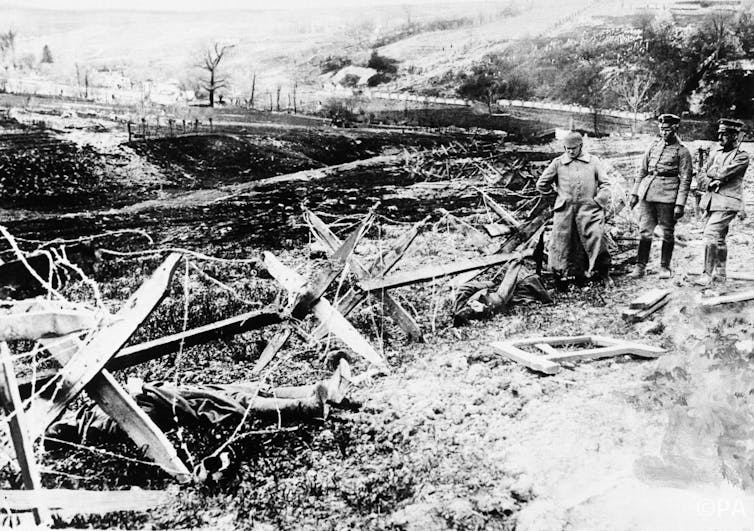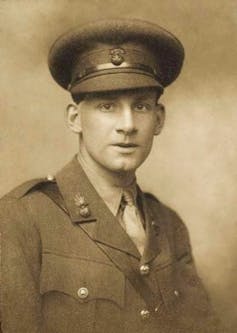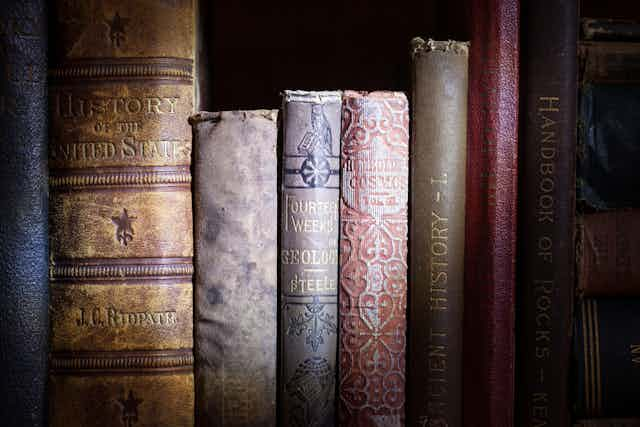Anniversaries encourage reflection. Now, 100 years after the start of the Great War, anyone who follows current affairs or reads a newspaper is part of a cultural conversation, a widespread reassessment of how our views of the war have been shaped. This has happened through stories, of course, but of what kind? Family stories, perhaps, but also those found in fiction, or poetry, or crafted by researchers into their accounts of the war. Some last longer than others. Why?
In 2005, two historians set out to summarise their discipline’s contribution to World War I literature. Jay Winter and Antoine Prost’s book opened with a head-count of relevant titles. There were more than 50,000 listed in the Paris library in which they had been working; a number they called “dizzying” then. And as the centenary approaches, bookshop tables are groaning under the weight of accumulated tomes, especially those published in recent months.
The versions keep on coming. New titles range from the acme of academic history, such as Winter’s own three-volume Cambridge History of the First World War, to more popular books, such as Mark Bostridge’s The Fateful Year: England 1914 or Florian Illies’ 1913: The Year Before the Storm, to Catastrophe: Europe Goes to War 1914, by prominent historian Max Hastings.
They are on display in every town in the country, and are being reviewed on a daily basis. Classic texts by Paul Fussell and John Keegan join them on the tables, while poetry sections display multiple editions of Siegfried Sassoon’s and Wilfred Owen’s verse.
With an increase in books comes an increase in views. Max Hastings’ Catastrophe is marketed as a counter-attack to the “poets’ view” of the war, summarised on its dust-jacket as the argument that war “was not worth winning”. A related article by Hastings in the Daily Mail in the summer of 2013 unleashed a tidal wave of media interest in what has also become known as the “Blackadder version” of the history of the war, with its supposed emphasis on futility. The hold that this version of the war above all others has on the nation’s imagination is clear from the lengthy coverage of the row – one in which senior politicians as well as writers and educationalists have become involved.
Michael Gove’s accusation that “left-wing academics” are seeking to hijack the story of war with self-serving myths of futility points to the heart of the matter: it is the supposedly “true” or “correct” story of war that is felt to be at stake. But the concept of a single story of war is itself a myth, and one that needs consigning to history, even as the lived memory of that war also passes away.
A very literary war
From the available evidence, it is at first hard to see what is mythical about the story of war. The patterns in the narrative leap out from multiple media. There are important visual clues to the ways in which we approach the war, or the ways in which publishers think we should, among the books on those tables.

Cover photographs of the Edwardian idyll are paired with those of dead soldiers, harshly dramatising before and after. Bostridge’s opening conceit, for example, is a camera shutter capturing a “carefree scene” on London’s Thames on Monday 3rd August, 1914. We note the doomed attempt at preservation and understand that all that is carefree is about to be lost: 1914 in this way becomes a watershed between the good old days and the horrors of the trenches. The starkness of this periodisation is undercut by the best history, but it’s the starkness that sells books, and it is as old as the war itself, as demonstrated by H. G. Wells in 1916:
The familiar scenery of life was drawn aside, and War stood unveiled. ‘I am the Fact’, said War, “and I stand astride the path of life. I am the threat of death and the extinction […] There can be nothing else and nothing more in human life until you have reckoned with me.

Loss and trauma, of course, are the prominent themes, and the transformative effects of World War I on language have been repeatedly explored. Wilfred Owen’s disillusioned poetry is the familiar face of World War I in British schools: Jeremy Paxman rightly surmises in Great Britain Goes to War that "we have all come to see the war through Wilfred Owen’s eyes”. Michael Gove might not like this story, but Owen’s poetic explosion of what he calls “the old Lie”, told by the establishment about the glory of sacrifice, is one that it is hard to overwrite.
And World War I was an intensely literary war. Education reform in Britain in the decades before the war extended literacy and therefore the ability to engage meaningfully with the ever-increasing amount of printed matter. This mass reading public, and the widespread participation of civilians in the war effort, meant that all parts of society were engaged in news about the conflict. The lack of competition from other media meant that it was a textually consumed war.
It was also textually mediated. One well-known literary critic, Sam Hynes, describes the war as a “great imaginative event”. He means that it was thought about, and then copiously written about, as well as prosecuted militarily and politically.
The story of the war that gradually evolved – the one that coalesced around Wilfred Owen and others from the 1930s, and the one that Michael Gove does not like – proved very powerful, so powerful that one historian has recently claimed that by 2013 the war had become a literary war, “detached from its moorings in historical events”.
The war needs to be wrestled back from literature, restored to and anchored in history, one infers. But of course, this would be impossible. One of the reasons for this is that the single powerful story itself falls apart on interrogation. Hynes is right that the war was a great imaginative event, but we need to re-approach the nature of that imagination, and its results in print.
Forgotten stories
F S Brereton might not be represented on school syllabi, but he wrote 48 novels, some of them about the 1914-1918 war, in which he served as a surgeon. Heroes, heroines, and evil spies populate his fiction, not war-ravaged trauma victims or alcoholics. Similarly, the reality of war encoded in Tell England, by Ernest Raymond, can be almost summarised by the narrator’s exclamation greeting the likelihood of war: “what fun!”.
Sales of Ernst Jünger’s In Stahlgewittern (published in English as Storm of Steel in 1929) went into six figures. Jünger’s version of war may have been more realistic about the experience of fighting than the tub-thumping adventure narratives of Brereton, but there’s no question of futility in his account.

What these examples demonstrate is that to an eager readership in the 1920s the story of war was very far removed from disillusionment. More than that, it was varied, and simply became more so once the now dominant novels and poetry found their way into print. And even these dominant examples reward scrutiny. Sassoon’s The Kiss recounts a soldier’s “good fury” and pleasure in a successful kill: the kiss is the discharge of a weapon into a body already prone.
Historical narratives are no more singular. The idea of a “lost generation” for example, central to many in the past, is now regularly challenged. And the routine and boredom of the frontlines are as integral to some accounts as the trauma is to others. Hastings admits “many alternative interpretations” of the war are possible – though one imagines the Blackadder version would not make it onto his list. A dominant narrative, once you train the gaze to look farther back, or wider afield, or explore the edges of the book tables, emerges as unattainable.
A dominant narrative should also be thought to be undesirable, whether or not it affirms what we think we know, or helps to sell books. It is only through acknowledgement of the multiplicity of stories, and the maintenance of an educational system that equips readers of all ages to interpret them, that World War I can come closer to being known and understood. Michael Gove is right to attempt to complicate the narrative, but not to try and produce for ideological reasons a new “story” of war.
The centenary cannot offer a complete picture of the Great War, but it does offer the opportunity to deepen and broaden our knowledge of the many stories that war tells.
This is a foundation essay for The Conversation’s new UK Arts + Culture section. If you are an academic or researcher with relevant expertise and would like to respond to this article, please use our pitch facility.

